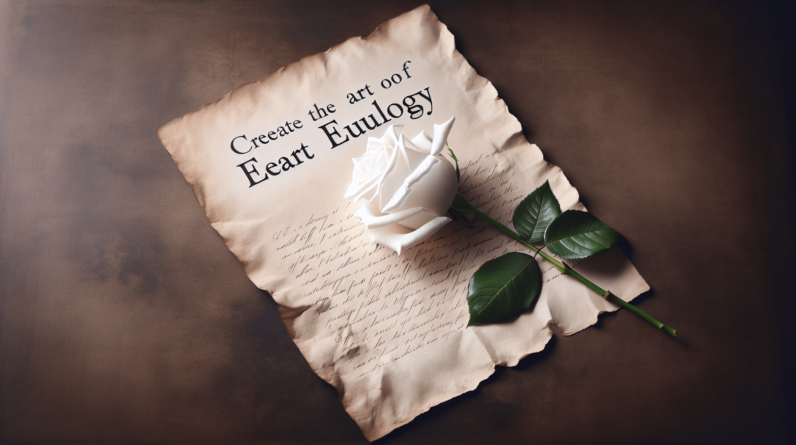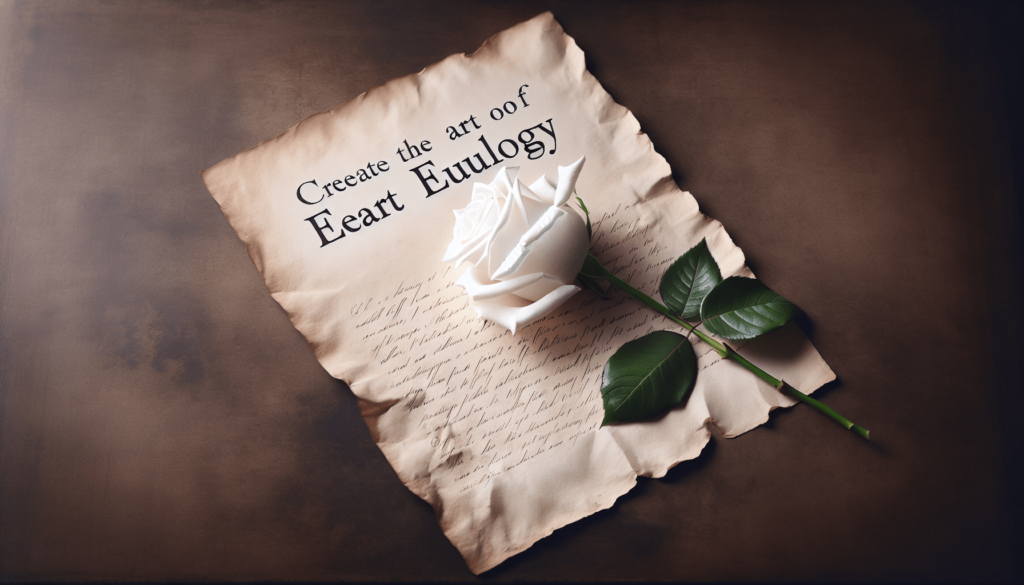
Losing a loved one is undoubtedly a difficult time, filled with a range of emotions and an overwhelming sense of grief. In such moments, writing a meaningful eulogy can provide solace and comfort, allowing you to honor and remember the life of the departed. It can be an opportunity to reflect on cherished memories, celebrate their accomplishments, and offer a heartfelt farewell. The task may seem daunting, but with a friendly and supportive tone, I am here to guide you through the process of crafting a eulogy that truly captures the essence and impact of your loved one’s life. So let’s embark on this journey together, and create a tribute that will leave a lasting impression.
Understanding the Purpose of a Eulogy
Losing a loved one is never easy, and saying goodbye can be one of the most challenging experiences in life. That’s where a eulogy comes in. A eulogy is a heartfelt tribute that allows you to honor and remember the life of the deceased. Its purpose goes beyond just sharing memories; it serves as a way to commemorate their life, provide comfort to friends and family, highlight significant accomplishments and personal traits, and set the tone for the memorial service.
Commemorating the deceased’s life
At its core, a eulogy is a way to celebrate and remember the life of the person who has passed away. It gives you the opportunity to reflect on their unique qualities, experiences, and contributions. By sharing their story, you honor their memory and create a meaningful tribute that captures their essence.
Providing comfort to friends and family
A eulogy serves as a source of comfort for the friends and family members who are mourning the loss of their loved one. It offers a chance to acknowledge their grief, share stories that bring laughter and tears, and remind everyone of the impact the deceased had on their lives. In this way, a eulogy becomes a healing tool, bringing solace and unity during a difficult time.
Highlighting significant accomplishments and personal traits
A eulogy is an opportunity to showcase the achievements and personal qualities that made the deceased unique. It allows you to celebrate their successes, whether they were in their career, personal life, or within the community. By highlighting their accomplishments and sharing stories that exemplify their character, you create a lasting tribute that captures the essence of who they were as an individual.
Setting the tone for the memorial service
A eulogy sets the tone for the entire memorial service, creating a framework for how the deceased will be remembered. It can create an atmosphere of reflection, celebration, or a combination of both. The way you craft and deliver the eulogy will set the tone for the service, guiding the emotions of those in attendance and helping them find solace and closure.
Gathering Insights and Memories
To create a meaningful eulogy, it’s important to gather insights and memories from those who knew the deceased best. This process involves consulting with close family and friends, recalling personal experiences and stories, researching the deceased’s life milestones, and collecting memorable quotes and sayings.
Consulting with close family and friends
Start by reaching out to close family members and friends of the deceased. They can provide unique insights and stories that will help shape the eulogy. Ask them about the person’s qualities, achievements, and memorable moments. Their input will give you a well-rounded perspective on the individual, allowing you to present a comprehensive eulogy.
Recalling personal experiences and stories
Reflect on your own personal experiences and memories with the deceased. Think about the moments you shared, the conversations you had, and the impact they had on your life. These personal anecdotes will add depth and a heartfelt touch to the eulogy, as you share intimate moments and connections you had with the person.
Researching the deceased’s life milestones
Do some research to gather information about the deceased’s life milestones. Look into their educational background, career achievements, hobbies, and any notable contributions they made within their community or profession. This will provide a well-rounded view of their life, ensuring that their accomplishments are properly acknowledged in the eulogy.
Collecting memorable quotes and sayings
Consider including memorable quotes or sayings that were important to the deceased or encapsulate their beliefs and values. These can be from famous individuals, religious texts, or personal expressions of the deceased themselves. Including these quotes in the eulogy adds depth and resonance, allowing their words to continue to inspire and comfort those in attendance.
Organizing Your Thoughts
Once you have gathered the necessary insights and memories, it’s time to organize your thoughts and create an outline for the eulogy. This process involves deciding on a theme or central message, balancing anecdotes with general information, and determining the overall tone of the eulogy.
Creating an outline for the eulogy
Start by creating an outline that organizes the content of the eulogy. Divide it into sections or paragraphs, each focusing on a specific aspect of the deceased’s life or personality. This will help ensure that you cover all the important points and maintain a cohesive structure throughout the eulogy.
Deciding on a theme or central message
Consider incorporating a theme or central message that ties the eulogy together. This could be a reflection of the person’s core values, a highlight of their greatest achievements, or a celebration of the impact they had on others. Choosing a theme will help guide the content of the eulogy and add a deeper layer of meaning to the overall tribute.
Balancing anecdotes with general information
As you craft the eulogy, find the right balance between sharing personal anecdotes and providing general information about the deceased. Anecdotes add a personal touch and help the audience connect with the person being honored, while general information provides a broader context for their life. Striking a balance will ensure that the eulogy is both relatable and informative.
Determining the tone: respectful, celebratory, or a mixture
Consider the overall tone you want to set for the eulogy. It can be respectful, celebratory, or a mixture of both, depending on the individual being honored and the preferences of their loved ones. The tone will guide the emotions of the audience, so it’s essential to strike the right balance and create an atmosphere that reflects the person’s life and spirit.

Writing Techniques for Emotional Impact
Writing a eulogy requires careful consideration of the language and storytelling techniques used. By employing descriptive storytelling, using metaphors and similes, incorporating humor appropriately, and maintaining authenticity and sincerity, you can create a eulogy that has a profound emotional impact.
Employing descriptive storytelling
Paint a vivid picture of the deceased’s life by employing descriptive storytelling techniques. Use specific details, sensory language, and imagery to transport the audience to important moments or experiences. This will make the eulogy more engaging and help the audience connect with the person’s life on a deeper level.
Using metaphors and similes for vivid imagery
Metaphors and similes can be powerful tools for creating vivid imagery and adding depth to the eulogy. Use these literary devices to draw comparisons that illustrate the person’s character, accomplishments, or impact. By creating relatable and memorable comparisons, you can evoke strong emotions and leave a lasting impression on the audience.
Incorporating humor appropriately
Humor can be an effective way to honor the deceased’s spirit and add warmth to the eulogy. However, it’s important to use humor appropriately and sensitively. Choose light-hearted anecdotes or humorous stories that celebrate the person’s personality without detracting from the overall tone of the eulogy. The goal is to bring smiles and laughter while still respecting the solemnity of the occasion.
Maintaining authenticity and sincerity
Above all, it’s crucial to maintain authenticity and sincerity throughout the eulogy. Speak from the heart and let your genuine emotions guide your words. Share personal stories and memories that reflect the true essence of the person being honored. By staying true to yourself and the memory of the deceased, you will create a eulogy that resonates with the audience and honors their legacy.
Highlighting the Deceased’s Values and Legacy
A eulogy offers an opportunity to highlight the values and legacy left behind by the deceased. By identifying their core beliefs, illustrating their impact on friends, family, and the community, sharing how they inspired those around them, and discussing the legacy they leave behind, you can create a truly meaningful tribute.
Identifying core values and beliefs
Take the time to identify the core values and beliefs that the deceased held dear. These could include integrity, compassion, resilience, or any other qualities that were central to their character. Highlighting these values in the eulogy celebrates the essence of who they were and reinforces the impact they had on others.
Illustrating the impact on friends, family, and community
Share stories and examples that illustrate the impact the deceased had on their friends, family, and community. Highlight their acts of kindness, contributions to their profession or community organizations, or any other ways in which they made a difference. By showcasing their influence, you honor their memory and inspire others to carry on their legacy.
Sharing how they inspired those around them
Describe how the deceased inspired and motivated those around them. Whether it was through their words of encouragement, their ability to lead by example, or their unwavering support, sharing these stories will demonstrate the positive influence they had on others. By highlighting their ability to inspire, you pay tribute to their character and encourage others to follow in their footsteps.
Discussing the legacy they leave behind
Take a moment to reflect on the lasting impact the deceased has left on the world. Whether it’s through their accomplishments, the lives they touched, or the values they instilled in others, discussing their legacy brings a sense of closure and ensures that their memory lives on. Recognize the ways in which their actions and influence will continue to shape the lives of those who knew them.
Acknowledging Grief and Offering Comfort
It’s essential to acknowledge the pain of loss and offer comfort to those in mourning during a eulogy. By recognizing the grief, sharing comforting words or quotes, offering hope and healing through remembrance, and guiding the audience in the grieving process, you can provide a source of solace and support.
Recognizing the pain of loss
Begin the eulogy by acknowledging the pain and grief felt by those in attendance. This simple act of recognition will validate their emotions and help create a safe space for them to mourn. By openly addressing the loss and offering empathy, you set the stage for a eulogy that acknowledges the complexity of grief.
Sharing comforting words or quotes
Incorporate comforting words or quotes into the eulogy that bring solace and hope. These can come from religious texts, famous authors, or the personal beliefs of the deceased. By offering these words, you provide comfort to those in mourning and remind them that they are not alone in their grief.
Offering hope and healing through remembrance
Encourage hope and healing through the power of remembrance. Share stories and memories that highlight the positive impact the deceased had on those around them. Use these moments to remind the audience of the joy and love that the person brought into their lives. By focusing on the positive, you offer a sense of hope for the future and support the healing process.
Guiding the audience in the grieving process
Use the eulogy as an opportunity to guide the audience in the grieving process. Share personal experiences of your own grief journey or offer suggestions for coping with loss. By providing guidance and support, you create a space for collective mourning and help the audience navigate the complexities of grief.
Practical Tips for Writing
Writing a eulogy can be a challenging task, but with some practical tips, you can create a meaningful tribute that truly honors the deceased. By maintaining brevity and clarity, editing for coherence and flow, asking for feedback from trusted individuals, and practicing aloud to check for tone and pacing, you can ensure that your eulogy resonates with the audience.
Maintaining brevity and clarity
Keep your eulogy concise and to the point. Focus on the most important aspects of the deceased’s life and highlight their significant achievements and qualities. Using clear and straightforward language will ensure that your message is easily understood by the audience.
Editing for coherence and flow
After writing the initial draft of your eulogy, take the time to edit it for coherence and flow. Read through the content and make sure that the transitions between paragraphs are smooth and logical. Remove any repetitive or unnecessary information to maintain the focus on the most impactful points.
Asking for feedback from trusted individuals
Share your eulogy with trusted individuals, such as family members or close friends, and ask for their feedback. They can provide insights and suggestions that will help you further refine and improve your tribute. Be open to constructive criticism and consider how their input can enhance the overall impact of your eulogy.
Practicing aloud to check for tone and pacing
Once you have finalized your eulogy, practice reading it aloud to check for tone and pacing. Pay attention to the emotions conveyed through your words and ensure that they align with the overall tone of the eulogy. Use pauses and changes in pace to create dramatic effect and maintain the audience’s engagement.
Memorable Closing Remarks
As you conclude the eulogy, aim to leave a lasting impression on the audience with your closing remarks. Summarize the key points gracefully, conclude with a significant quote or poem that encapsulates the essence of the person being honored, leave the audience with a message that resonates, and express gratitude for their presence and support.
Summarizing key points gracefully
In the closing remarks, gracefully summarize the key points and highlights from the eulogy. Remind the audience of the core aspects of the deceased’s life and character that were discussed. This summary will tie the eulogy together and leave a lasting impression on the audience.
Concluding with a significant quote or poem
Wrap up the eulogy with a significant quote or poem that captures the essence of the person being honored. Choose something that resonates with their beliefs, character, or values, and that will evoke strong emotions in the audience. By concluding with powerful words, you ensure that the memory of the deceased lingers in the hearts of those in attendance.
Leaving the audience with a lasting message
Leave the audience with a lasting message that sums up the impact and legacy of the deceased. Whether it’s a call to action, a reflection on the importance of cherishing loved ones, or a reminder of the lessons learned from the person’s life, this message will serve as a final tribute and provide a source of inspiration for those in attendance.
Thanking the audience for their presence
Finally, express your gratitude to the audience for their presence and support during this difficult time. Thank them for honoring the memory of the deceased and for joining together to celebrate their life. This gesture of appreciation will create a sense of unity and foster a supportive environment.
Overcoming Challenges in Eulogy Writing
Writing a eulogy can be a challenging task, particularly when addressing complicated relationships or aspects, balancing personal emotions with public speaking, adapting the eulogy for unforeseen circumstances, and feeling overwhelmed. However, with some guidance and support, these challenges can be overcome.
Addressing complicated relationships or aspects
When writing a eulogy, it’s important to consider complicated relationships or aspects of the deceased’s life. If certain topics or relationships are sensitive, approach them with empathy and sensitivity. Focus on the positive aspects and avoid dwelling on any conflicts or controversies. The goal is to honor the person’s memory and create a healing environment for all in attendance.
Balancing personal emotions with public speaking
Writing a eulogy requires balancing your personal emotions with the need to deliver a heartfelt and composed tribute. Allow yourself to be authentic and emotional, but also maintain composure and clarity as you speak. Take breaks if needed and lean on a supportive network to provide emotional strength throughout the process.
Adapting the eulogy for unforeseen circumstances
In some cases, unforeseen circumstances may arise that require adjustments to the eulogy. This could include finding out new information about the deceased or accommodating unexpected speakers or events during the memorial service. Stay flexible and be willing to adapt the eulogy as necessary, ensuring that it remains a meaningful tribute in any situation.
Seeking support when feeling overwhelmed
Writing a eulogy can be overwhelming, especially when dealing with grief and loss. Remember that you don’t have to go through the process alone. Seek support from friends, family, or professionals who can provide guidance and assistance. Sharing the burden and seeking help will ensure that you can create a powerful and meaningful eulogy without feeling overwhelmed.
Resources for Further Assistance
If you find yourself in need of additional assistance or guidance when writing a eulogy, there are resources available to support you through the process. Consider exploring books and articles on eulogy writing, attending workshops and seminars in Houston, Texas, reaching out to professional eulogy writers and funeral directors, or joining online forums and support groups specifically dedicated to this topic. These resources can provide valuable insights and advice, helping you create a truly meaningful tribute to honor your loved one.





